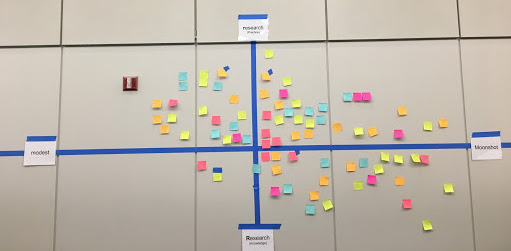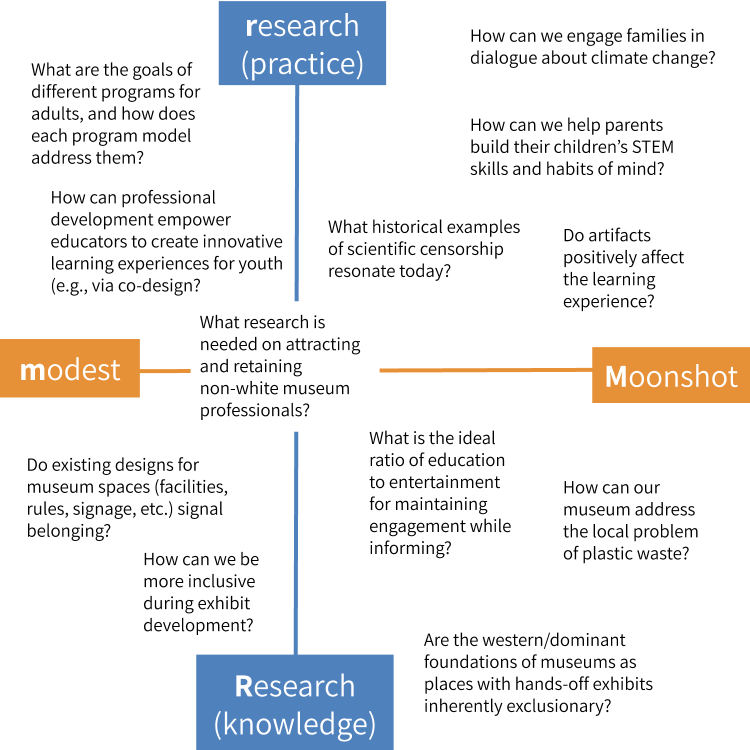Modest to Moonshot: The Future of Research and Development in Science Museums
This blog was co-written with Josh Gutwill, Director of Visitor Research and Evaluation at the Exploratorium in San Francisco, CA. James (Jamie) is the Project Director and Principal Investigator of the Center for the Advancement of Informal Science Education (CAISE).
Over the next five years, what topics will museums and science centers address in their exhibits and programming, and what questions will they study? A session at the Association of Science and Technology Centers (ASTC) 2019 annual conference, called From Modest to Moonshot, focused on research and development (R&D) in science museums. Three institutions presented their current work and plans in R&D:
- At the Children’s Museum of Pittsburgh, current work is driven by the overarching question of how to create conditions to notice opportunities for learning. The museum has initiated an R&D partnership in a dedicated building called museumlab, in order to develop practices such as values-based reflection, as well as adopting a “small bets” methodology for mini-experiments at the intersection of informal and formal learning. Some exhibition elements are turned over to partner organizations and museumlab is exploring how they can best design for and support social-emotional learning. Presented by Lisa Brahms and Chip Lindsey.
- The Museum of Science in Boston embraces the intersection of inclusion, emotion, and multiple ways of thinking to ask this overarching R&D question: “How do we empower everyone to leverage STEM ways of thinking and take action to shape a better future?” The museum is investigating the role of emotion and affect in how underrepresented groups experience exhibits, considering how interdisciplinary perspectives on imagination could be systematically applied to exhibits and programs, and studying how learning can be supported while museum visitors engage in "productive struggle" with interactive exhibits. Presented by Christine Reich and Elizabeth Kollmann.
- The Exploratorium identifies as an institution that has always had R&D at its core, and it recently articulated a research agenda that will guide and ground their work over the next five years. The four pillars of the agenda roughly scale out from the individual to the global. Presented by Josh Gutwill and Tom Rockwell.
- Advancing inquiry (How can we broaden and deepen scientific inquiry in museums?)
- Exploring identity (How can informal learning experiences centered on the role of social identity illuminate inequities and advance social justice?)
- Engaging ecology (What communication strategies catalyze people to be more open, engaged, and positive in response to environmental issues?)
- Fostering civic agency (How do we inspire different groups of people—including policy-makers, scientists, artists, and community members—to collaboratively construct a just society?)
The Audience Looks Toward the Future

Session attendees generated, discussed, and shared their own R&D questions—ones they hoped the field would try to understand in the coming years. The result was a graph of over 70 R&D questions (see above), categorized along two dimensions:
- Scale of effort (x-axis): The “m” scale runs from “modest” to “Moonshot,” where modest refers to “small bets” methodology that is relatively simple and easy to implement, while Moonshots might represent risky or expensive efforts.
- Type of activity (y-axis): The “r” scale runs from “little r research” that might represent wisdom and lessons learned from reflective practice to “big R research” where the primary focus of the work is on knowledge building.
This graph illustrates some examples of the questions posed:

Our Reflections on the Exercise
Josh: “I’m struck by the diversity of the questions, even within a single quadrant. The topics range from adult learning to stimulating curiosity to improving professional development to investigating exclusionary practices in the museum field. So many incredibly interesting topics to choose from!
The two-dimensional scale does help me think about strategy, though. As a researcher, I’m particularly drawn to the modest Research quadrant for questions that can be tackled relatively quickly and easily, such as ‘Why do some adults come or not come to science centers?’
The field actually knows quite a bit about why adults come to science centers. For example, John Falk and others have published extensively on motivation for visiting, and the Collaboration for Ongoing Visitor Experience Studies (COVES) project is collecting exit data at dozens of science museums about visitors’ reasons for visiting. They publish an annual report on this issue. Although the field knows less about why adults do not visit, there is a growing body of research, such as work done by Emily Dawson, that focuses on barriers to visitation and private organizations such as MuseumNext that are dedicated to helping museums attract and engage more visitors.
The Moonshot Research quadrant contains wonderfully juicy questions, such as ‘What is the long-term impact of multiple experiences on children in our museum?’ and ‘Are the foundations of the museum as a place with exhibits inherently exclusionary (i.e., inherently based in western ways of learning/public participation)?’ A researcher could build a career on some of these questions.”
Jamie: “It was interesting that the majority of the questions were posted toward the ‘Moonshot’ side of the grid and that themes emerged across all four quadrants. Some of these themes were families and parents as audiences, STEM topics of societal concern, staff diversification and professional development, and how to better measure the effectiveness of a variety of approaches to facilitating learning.
The session demonstrated the thoughtfulness with which professionals across the field, regardless of their role, are going about their work. It also provided an opportunity to reflect on how research and development in the science center and museum sector can both inform and be informed by studies and design occurring in other informal STEM learning settings.”
R&D Projects Funded by the National Science Foundation
In 2019, NSF's Advancing Informal STEM Learning (AISL) program funded several projects within its that provide examples of how science centers and museums work together with partners to engage audiences and communities and build knowledge for the wider field. These are awarded under NSF's categories of “Research in Service to Practice” and “Innovations in Development.”
- An experimental study of the impact of museum field trips on STEM career awareness through a race and ethnic identity lens (description)
- Building more inclusive makerspaces to support informal engineering learning experiences (description)
- Cambio: A professional development approach for building Latinx-focused cultural competence in informal science education institutions (description)
- Establishing a learning network to connect museums, scientists, and rural communities to discuss scientific information to inform transdisciplinary problem-solving (description)
- Head start on engineering: Developing a learning community to study and support family-level interest in engineering (description)
- Hidden no more: Shedding light on science stories in the shadows (description)
- Making space for story-based tinkering to scaffold early informal engineering learning (description)
- Practice-driven research: Developing constructivism-informed tools for supporting learning in informal contexts (description)
- Roads taken: A retrospective study of program strategies and long-term impacts of intensive, multi-year, STEM youth programs (description)
If you have R&D ideas to share and explore with colleagues, consider submitting a session proposal for the 2020 ASTC annual conference in Pittsburgh, PA. Proposals are due January 15, 2020.